Naval Mobile Construction Battalion 1
Naval Mobile Construction Battalion 1 (NMCB 1), is a United States Navy Seabee battalion. NMCB 1 has a long, proud and distinguished history as the very first Naval Construction Battalion of the service that would become known as the Seabees.
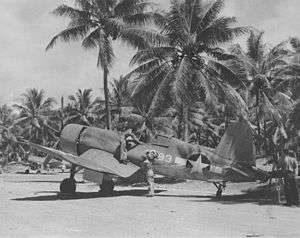
| Naval Mobile Construction Battalion 1 | |
|---|---|
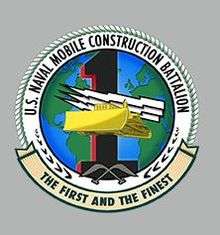 NMCB 1 insignia | |
| Active | 15 March 1942 – present |
| Country | United States |
| Branch | USN |
| Part of | 22nd Naval Construction Regiment |
| Homeport | Construction Battalion Center Gulfport |
| Nickname(s) | "The First and the Finest" |
| Engagements | World War II Vietnam War Gulf War Operation Enduring Freedom Operation Iraqi Freedom |
| Commanders | |
| Current commander | CDR Robert Stiles |
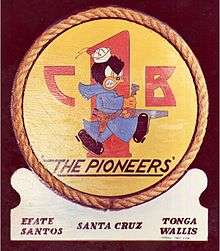
History
Commissioned on 15 March 1942 as Naval Construction Battalion 1. The Battalion was split into 2 Construction Detachments. The 2nd Construction Detachment went to Tongatabu and the 3rd Construction Detachment went to Efate, New Hebrides.[2] The Seabee name did not exist when these groups deployed.[3]
World War II
Mid-year 1941 CB 1 did not exist, civilian contractors were working large construction contracts at Guam, Midway, Wake, Pearl Harbor, Iceland, Newfoundland, and Bermuda. BuDocks decided to improve the Navy's supervision through the creation of "Headquarters Construction Companies".[4] These companies would report to the Officers in Charge of Construction. They would be the draftsmen and engineering aids needed by the inspectors and supervisors to do their work.[4] These companies would consist of two officers and 99 enlisted men, but would do no any actual construction. Rear Admiral Chester Nimitz, Chief of the Bureau of Navigation, authorized the formation of the first Hq Company on 31 October 1941.[4] Recruitment started in November and the company was formed on 7 December. The men went through boot at Naval Station Newport, Rhode Island. By 16 December 1941, four additional companies had been authorized.[4] December 7th happened changing plans and with them the ratings needed by a change in mission. The first Company formed provided the nucleus for the formation of the 1st Naval Construction Detachment sent to Bora bora. In the beginning that detachment was called the 1st CB, but Budocks decided it's size made that an incorrect identification. It then became the 1st Naval Construction Detachment. With the outbreak of war, Admiral Ben Moreell, Chief of BuDocks, recommended creating three Naval Construction Battalions and on December 28 requested authority to carry this out. On 5 January 1942, the Bureau of Navigation authorized recruitment of tradesmen for those Battalions. Simultaneous to Adm. Moreell's Battalion request, the other four Hq Construction Companies had been approved. So, Hq Companies 2 & 3 were combined to form the 1st Naval Construction Battalion and deployed as the 2nd & 3rd Construction Detachments. Upon completion of training, CB 1 was sent to the South Pacific for 23 months in the Tonga and Samoan Islands.[5] The Detachments built runways, quonsit bases, gun emplacements, and petroleum tank farms. The Fua'amotu International Airport and Faleolo International Airport were created as projects of the 2nd Construction Detachment. The 3rd Construction Detachment built Quoin Hill Airfield on Efate that was abandoned in 1946 as well as a bomber base. A detail from the 3rd detachment was rushed from Efate to Espirito Santo to build a bomber strip to attack the Japanese on Guadalcanal.[6] Also on Efate were the 4th Marine Defense Battalion[7] and the 24th Infantry Regiment(colored). The Marines sent an AA Battery and the Army sent an Infantry Company to help the Seabees. Together, working around the clock, they cleared and laid a 6,000' runway in the jungle in 20 days.[6] Fighters landed the day after completion and B17s came the next. The Turtle Bay Airfield became a fighter strip that today is abandoned to nature. Major Pappy Boyington with his VMF-214 were stationed at Turtle bay in 1943. Another Medal of Honor winner flying out of the base was 1st Lt. Kenneth A. Walsh of VMF-124. The Battalion was sent stateside and decommissioned in June 1944.
Post-war
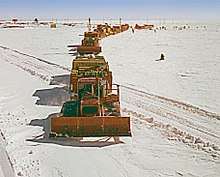
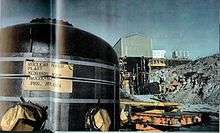
In 1949, the Navy went through a reorganization that created a new type of construction unit – the Mobile Construction Battalion (MCB). On 8 August 1949, U.S. Naval Mobile Construction Battalion 1 (MCB 1) was established at Naval Amphibious Base Little Creek, Virginia and was formally commissioned on 28 October.[8] In December the battalion took part in a multi-service Operation PORTEX on Vieques, Puerto Rico. In 1951 homeport changed when the Battalion moved from Little Creek to Davisville, Rhode Island.[8] During the next four years the Battalion would go to Puerto Rico; Guantanamo Bay, Cuba; Bermuda; Port Lyautey, French Morocco; Argentia, Newfoundland; and Rota, Spain. In 1956, the Battalion went to Antarctica and participated in Operation Deep Freeze II. During that deployment MCB 1 had detachments on six continents.[8] MCB 1 returned to Antarctica in 1961 to assemble a nuclear power plant[9] for which the Battalion received the Navy Unit Commendation.[10]
Vietnam
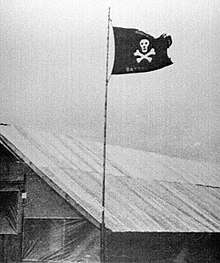
MCB 1 was the first Alantic Fleet Battalion to deploy to Vietnam.[8] From 1966 to 1970, the Battalion made four consecutive deployments to Southeast Asia.[8] During the second deployment an urgent airfield was needed at Quảng Trị.[8] The project was designated "top secret", site "X", and to be completed in under 45 days. MCBs 1, 3, 4, 7, 11, 74, 121, and 133 all sent detachments of men and equipment to get the job done. Those detachments dubbed themselves the Ghost Battalion and chose the Jolly Roger for the Battalion's colors[11] The Ghost Battalion was dis-banded 1 November 1967. While making those deployments four NMCB One members made the ultimate sacrifice serving their country. Their names were Constructionman Starkey, Steelworker 3rd Class Williams, Chief Builder McGinn, and Lieutenant Junior Grade Moscrip.
One's Seabee Teams
- 0101 1968 Chau Phu
- 0102 1968 Phu Vunh
- 0103 1969 My Tho
- 0104 1969 Xuan Loc Special Forces Camp
- 0105 1970 Bac Lieu
- 0106 1970 Ham Tan
- 0107 1970 Tam An
1970s through present
%2C_Air_Detachment%2C_work_to_construct_a_canopy_for_the_Fallujah_Surgical_Facility_at_Camp_Fallujah%2C_Iraq.jpg)
_1%2C_gives_instruction_to_the_Seabees_of.jpg)
From the fall of 1971 through early summer of 1972, NMCB 1 was the second battalion to occupy and construct the British Indian Ocean Territory station on Diego Garcia. They relieved Naval Mobile Construction Battalion 40, who had landed, nine months earlier, on the island by LSDs and LSTs. They constructed the facilities that NMCB 1 would complete over their nine-month deployment. The runway that NMCB 1's advanced party landed on in C-130s was 3000 feet long. When MCB 1 left, the runway was 11,500 feet. It was at grade and ready for NMCB 62 to pour, 50'wide x 12"thick x 11,500'long in concrete. NMCB 1 also made the concrete silos for storing the cement to pour the runway. The Battalion also prepared the aggregate piles by blasting and mining coral and rock, crushing it and stock piling it for 62's use. The pile was over 500 feet tall, creating a mountainous hill on the island, whereas the average elevation had originally been 6.5 feet above sea level.
In 1974 NMCB 1 was the last Battalion to deploy from Davisville. When the Battalion returned from Rota, it was to Naval Construction Battalion Center, Gulfport, Mississippi.[8]
1983 Beirut barracks bombing: On 23 October 1983 a truck laden with explosives was driven into the U.S. Marine's peacekeeping force barracks in Beirut. Killed were: 220 Marines, 18 USN, 3 U.S. Army with 80 seriously wounded.[12] NMCB 1 quickly deployed a 42-man det to construct bunkers for the Marines. An additional 40 men were sent to get the job done[12]
NMCB 1 sent two details in 1990 to Saudi Arabia in support of Operation Desert Shield and Operation Desert Storm.[8] The following year, the Battalion provided disaster relief following super typhoons on Guam and American Samoa. Upon returning to homeport in May 1992, the Battalion was again providing disaster relief, this time in South Florida in the aftermath of Hurricane Andrew. In December 1992, NMCB 1 redeployed from Rota to Somalia in support of Operation Restore Hope.[8]
A 180-person detachment was sent to Bosnia-Herzegovina in December 1997 to support Operation Joint Guard.[8] NMCB 1 returned to the Balkans when a 97-person detachment arrived in Kosovo tasked to Task Force Falcon in December 1999.[8] During the 2000 European deployment, Detail Souda Bay assisted disaster recovery operations in remote Crete villages following torrential rains.[8]
In June 2002, the Battalion deployed to Okinawa, Japan for the first time since 1987, with construction projects across the Pacific. Upon arriving in Okinawa, the Battalion immediately sent an Air-Det of 102 Seabees to Basilan Island, in the PI, in support of Operation Enduring Freedom. Under hostile conditions, the Air-Det improved roads, drilled wells, built bridges and base camps and rebuilt a timber pier.[8]
During its 2003–2004 Pacific Deployment, the Battalion became the first CB to have two main-body deployment sites: Rota, Spain and Guam. NMCB 1 had construction operations in the Atlantic, European, Pacific and Central Command Areas of Responsibility, while deploying its Air-Det in support of Iraqi Freedom. In September 2004, NMCB 1 assisdisaster recovery operations at NAS Pensacola following Hurricane Ivan.[8]
For the 2005 European deployment NMCB 1 had details tasked in twelve countries throughout Europe, Africa, Asia, and the Caribbean. The Air Det returned to Iraq in support of Operation Iraqi Freedom. Hurricane Katrina disaster recovery operations greeted ONE's return to homeport in August 2005.[8]
In June 2006, NMCB 1 deployed to 20 sites in 9 countries as part of their Pacific deployment. The Battalion was tasked with construction projects in Okinawa, Atsugi, Sasebo, Yokosuka, Iwakuni, Fuji, Chinhae, Pohang, Diego Garcia, Camp Pendleton, and San Clemente Island, contingency operations in Pohnpei, Indonesia, Philippines, and Afghanistan, and prison detainee operations in Iraq.[8]
In September 2007 the Battalion deployed to 16 different sites throughout CENTCOM, PACOM, and NORTHCOM. NMCB 1 provided contingency construction and engineering support to both Operation Iraqi Freedom II and Operation Enduring Freedom. While supporting the mission in CENTCOM, the Battalion was tasked with construction projects in Guam and San Nicolas Island (SNI), CA. Those dets returned to the main body mid-deployment.[8]
Unit awards
A unit citation or commendation is an award bestowed upon an organization for the action cited. Members of the unit who participated in said actions are allowed to wear the awarded unit citation on their uniforms. NMCB 1 has been presented with the following awards:[13][14]
- Navy Unit Commendation 4 awards: Antarctica 1962; Vietnam 1968, 1969, and 1970[15]












Campaign and service awards
![]()
![]()









- Chief of Naval Operations Letter of Commendation 2009[17]

- Peltier Award 7 awards[17]
See also
| Wikimedia Commons has media related to Naval Mobile Construction Battalion 1. |
- Admiral Ben Moreell
- Amphibious Construction Battalion 1 (ACB-1)
- Amphibious Construction Battalion 2 (ACB-2)
- Civil Engineer Corps United States Navy
- Naval Construction Battalion aka Seabee
- Naval Amphibious Base Little Creek
- Naval Amphibious Base Coronado
- Naval Construction Battalion Center (Gulfport, Mississippi)
- Naval Construction Battalion Center Port Hueneme
- Naval Mobile Construction Battalion 3
- Naval Mobile Construction Battalion 4
- Naval Mobile Construction Battalion 5
- Naval Mobile Construction Battalion 11
- Naval Mobile Construction Battalion 25
- Naval Mobile Construction Battalion 133
- Seabees in World War II
- Seabees Memorial
References
- Naval Construction Battalion Logos, flickr website, U.S. Navy Seabee Museum, Port Hueneme, Ca
- 1st Naval construction Battalion,NMCB62 alumni webpage CB Unit Histories
- Seabees with the Marines, U.S. Navy Seabee Museum Archives, Port Hueneme, CA 93043
- Seabee History: Introduction, Naval History and Heritage Command official U.S. Navy web site, Published: Fri Feb 17 06:36:45 EST 2017
- Efate Espiritu Santo, Building the Navys Bases in WWII, GPO Washington DC, 1947
- {{cite web|title= Seabee History: Formation of the Seabees and World War II|url= https://www.history.navy.mil/research/library/online-reading-room/title-list-alphabetically/h/history-of-seabees/ww2.html%7Cwebsite=NHHC
- Efate, Building the Navy's Bases in World War II, Vol II (Part III), GPO Washington DC, 1947
- History, Naval Mobile Construction Battalion 1, official United States Navy Website, NMCB 1, 5301 Bainbridge Ave Box #61, Gulfport, MS 39501
- Antarcticsun NSF webpage, National Science Foundation, Office of Polar Programs Geosciences Directorate, 2415 Eisenhower Avenue Suite W7100, Alexandria, VA 22314 U.S. Antarctic Program
- MCB 1 Cruisebook, Seabee Museum Archives, Port Hueneme, CA.MCB 1 Cruisebook 1962-1963
- Naval History and Heritage Command, U.S. Navy Seabee Museum, The Ghost Battalion
- Seabee Museum Rhode Island history webpage
- U.S.Navy unit awards Chief of Naval Operations
- "Chief of Naval Operations" (PDF). Archived from the original (PDF) on 31 January 2017. Retrieved 14 May 2017.
- Global Security.com
- Humanitarian Service Medal, Approved Operations, DOD Office of the Under Secretary for Personnel and Readiness
- Seabee Website
External links
- Facebook NMCB1
- NMCB14 2004 OIFII Deployment
- NMCB 1 homepage
- Global Security
- Seabee Unit Histories
- NAVDOCKS-100, January 1944, U.S.Naval Construction Battalion Administration Manual
- 1 NCB & NMCB 1 Unit Histories and Cruisebooks search "deployment completion reports"